Click on images to enlarge
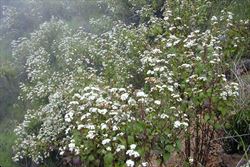
infestation (Photo: Forest and Kim Starr, USGS)

habit in flower (Photo: Sheldon Navie)
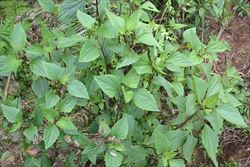
the bright green, oppositely arranged, leaves (Photo: Sheldon Navie)

close-up of the relatively broad and almost triangular leaves (Photo: Sheldon Navie)

the branched flower clusters at the tips of the stems (Photo: Sheldon Navie)
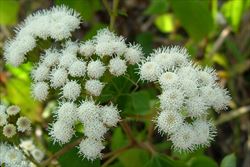
the small white flower-heads are borne in dense clusters (Photo: Sheldon Navie)

close-up of the flower-heads, each with numerous tiny tubular flowers (Photo: Sheldon Navie)

close-up showing the greenish flower-head bracts and the sticky hairs on the young stems (Photo: Sheldon Navie)

seedling (Photo: Sheldon Navie)
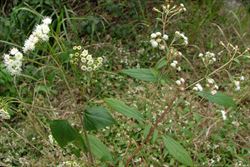
comparison of crofton weed (Ageratina adenophora), left, and mistflower (Ageratina riparia), right (Photo: Sheldon Navie)
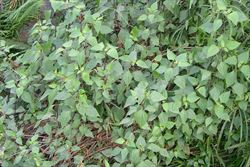
habit prior to flowering (Photo: Sheldon Navie)
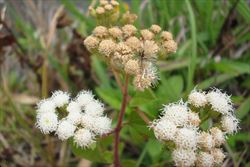
older flower-heads and 'seeds' (Photo: Sheldon Navie)

close-up of seeds (Photo: Julia Scher)
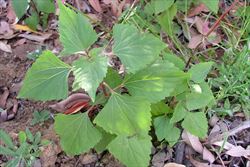
young plant (Photo: Sheldon Navie)
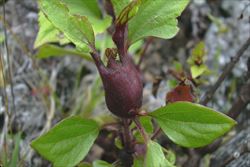
damage caused by the crofton weed gall fly (Procecidochares utilis), a biolological control agent (Photo: Forest and Kim Starr, USGS)
Scientific Name
Ageratina adenophora (Spreng.) R.M. King & H. Rob.
Note: Eupatorium adenophorum Spreng. is currently used in Western Australia.
Synonyms
Eupatorium adenophorum Spreng.
Family
Asteraceae (Queensland, New South Wales, the ACT, Victoria, Tasmania, Western Australia and the Northern Territory)Compositae (South Australia)
Common Names
cat weed, catweed, crofton weed, croftonweed, hemp agrimony, Mexican devil, sticky agrimony, sticky eupatorium, sticky snakeroot, white thoroughwort
Origin
Native to Mexico.
Naturalised Distribution
Widely naturalised in eastern Australia and also present in some parts of southern Australia. It is common in the coastal and sub-coastal districts of southern and central Queensland and eastern New South Wales, as far south as Wollongong, and is particularly abundant in the areas adjacent to the Queensland/New South Wales border. It is also common on Lord Howe Island, occasionally naturalised near Adelaide in south-eastern South Australia and near Perth in south-western Western Australia, and sparingly naturalised near Melbourne in southern Victoria.
Widely naturalised in many other parts of the world, including in southern Europe, Africa, Asia, New Zealand, south-western USA (i.e. California), French Polynesia, Fiji and Hawaii.
Habitat
This species is a weed of roadsides, railways, pastures, fence-lines, disturbed sites, waste areas and waterways in sub-tropical and warmer temperate regions. It it is also commonly found in urban bushland, open woodlands, forest margins, rainforest clearings and plantation crops (e.g. bananas and sugar cane).
Habit
A long-lived (i.e. perennial) herbaceous plant or small soft-stemmed shrub usually growing 1-2 m tall, but occasionally reaching up to 3 m in height. It produces numerous upright (i.e. erect) stems from a woody rootstock.
Distinguishing Features
- a long-lived herbaceous plant or small shrub growing up to 2 m tall.
- it produces upright, branched stems from a woody rootstock.
- its stems are covered in sticky hairs when young and bear pairs of oppositely arranged leaves.
- its leaves are relatively broad, diamond-shaped or almost triangular in shape (4-15 cm long and 3-9 cm wide), and have toothed margins.
- its small white flower-heads are borne in dense clusters at the tips of the branches.
- its roots are yellowish in colour and give off a distinct carrot-like smell when broken or damaged.
Stems and Leaves
The branched stems are densely covered in sticky (i.e. glandular) hairs when young and may be green, reddish or purplish in colour. They become slightly woody and turn brownish-green or brown in colour when mature.
The leaves are oppositely arranged along the stems and are borne on stalks (i.e. petioles) 1-6 cm long. The leaf blades (4-15 cm long and 3-9 cm wide) are trowel-shaped, diamond-shaped (i.e. rhomboid), or triangular with bluntly or sharply toothed (i.e. crenate or serrate) margins. These leaves have sharply pointed tips (i.e. acute apices) and are mostly hairless (i.e. glabrous), but their stalks (i.e. petioles) are often covered in sticky hairs (i.e. they are glandular pubescent).
Flowers and Fruit
The small flower-heads (i.e. capitula) lack large 'petals' (i.e. ray florets) and consist of several tiny flowers (i.e. tubular florets) surrounded by two rows of greenish bracts (i.e. an involucre) 3-5 mm long. These flower-heads (5-8 mm across) are borne in large numbers and arranged in clusters at the tips of the branches (i.e. in terminal corymbose inflorescences). The tiny tubular florets (3-5 mm long) are white and contain both male and female flower parts (i.e. they are bisexual). Flowering occurs mostly during spring and early summer in northern regions, and during late summer and autumn in southern regions.
The 'seeds' (i.e. achenes) are slender, reddish-brown or blackish-brown in colour, and slightly curved. These 'seeds' (1-2 mm long and 0.3-0.5 mm wide) have four or five slight ribs which run lengthwise (i.e. longitudinally) and their bodies are hairless (i.e. glabrous). However, they are topped with a ring (i.e. pappus) of numerous whitish hairs (3-4 mm long), which are readily shed.
Reproduction and Dispersal
This plant reproduces mainly by seed. These seeds are easily dispersed by wind and float on water. They may also be spread in by animals and vehicles and can contaminate agricultural produce.
Environmental Impact
Crofton weed (Ageratina adenophora) is regarded as a significant environmental weed in Queensland and New South Wales, and was recently listed as a priority environmental weed in four Natural Resource Management regions in these states. This species colonises forest margins, stream banks and disturbed areas, preferring shaded wetter areas but also growing in open sunny sites. It also thrives in damp areas such as wetland margins, drainage lines, gullies and in clearings in wetter forests. It grows in large dense clumps and will eventually out-compete all other plants in an area, choking out native vegetation and forming a monoculture.
In Queensland, crofton weed (Ageratina adenophora) is most prevalent in south-eastern parts of the state, where it invades pastures and colonises natural areas. It is a very significant environmental weed in south-eastern Queensland, where it was recently ranked among the top 20 most invasive plant species.
In New South Wales, crofton weed (Ageratina adenophora) is prominent as an environmental weed in the north coast region as well as on the central coast and in wider Sydney and Blue Mountains region. It is most common in northern New South Wales, but is also relatively common along the central coast and in the northern parts of the south coast. This species appears on several local environmental weed lists in the Sydney area (e.g. in Randwick City, Warringah Council and Sutherland Shire) and is one of the most common weeds in the Sutherland Shire, in southern Sydney. It also commonly invades State forests and National Parks in eastern New South Wales. Crofton weed (Ageratina adenophora ) is also listed as a principal weed species in lowland rainforests in eastern New South Wales, an ecological community that has been given an endangered listing in this state.
Crofton weed (Ageratina adenophora) is also a weed of particular concern on Lord Howe Island. This species tends to locally dominate exposed sites, where it excludes native species. It occurs at many sites on the island, but is particularly apparent on exposed mountain slopes (e.g. on Mount Gower). It is considered to be having a serious impact on the World Heritage values of Lord Howe Island and threatening the survival of two endangered plant species on the island (i.e. Carmichaelia exsul and Calystegia affinis).
These are not the only rare native species to be threatened by crofton weed (Ageratina adenophora). Invasion of habitat by this weed is also seen as a threat to the vulnerable Hartman's sarcochilus (Sarcochilus hartmannii), an epiphytic orchid in north-eastern New South Wales, and the Border Ranges daisy (Brachyscome ascendens), and endangered species restricted to highland areas in south-eastern Queensland and north-eastern New South Wales. The endangered native jute (Corchorus cunninghamii) is also threatened by invasion of crofton weed (Ageratina adenophora) and other weed species at many of the locations where it is known to exist. The giant spear lily (Doryanthes palmeri) is another vulnerable native species from south-eastern Queensland and north-eastern New South Wales that is threatened by crofton weed (Ageratina adenophora). One study found that seedlings of this species that had begun to establish were soon out-competed by crofton weed (Ageratina adenophora), and that there were dense populations of this and other weed species in some of the sites were this species is found.
Other Impacts
Crofton weed (Ageratina adenophora) is also an aggressive weed in pastures in eastern Australia. It prefers wetter pastures (e.g. kikuyu grass pastures on wetter slopes), is usually not eaten by cattle, and can reduce the carrying capacity and productivity of invaded areas.
It is also poisonous to livestock, being particularly toxic to horses. In fact, this species is the cause of an acute pulmonary disease in horses which is known as "Tallebudgera horse disease" in Queensland and "Numinbah horse sickness" in New South Wales. This condition can be fatal if enough of the weed is consumed over a long period.
Legislation
This species is declared under legislation in the following states and territories:
- New South Wales: Class 4 - a locally controlled weed. The growth and spread of this species must be controlled according to the measures specified in a management plan published by the local control authority and the plant may not be sold, propagated or knowingly distributed (in a large number of local authority areas). See the New South Wales Department of Primary Industries Noxious Weeds List at http://www.dpi.nsw.gov.au for more detailed information on which local areas are covered in these declarations.
- Western Australia: Prohibited - on the prohibited species list and not permitted entry into the state.
Management
For information on the management of this species see the following resources:
- the New South Wales Department of Primary Industries Agfact on this species, which is available online at http://www.dpi.nsw.gov.au.
- the Biosecurity Queensland Fact Sheet on this species, which is available online at http://www.dpi.qld.gov.au.
- the Sutherland Shire weed fact on this species, which is available online at http://www.sutherland.nsw.gov.au.
Similar Species
Crofton weed (Ageratina adenophora) is very similar to mistflower (Ageratina riparia), which is also known as 'creeping crofton weed', and relatively similar to Siam weed (Chromolaena odorata) and Senegal tea plant (Gymnocoronis spilanthoides). These species can be distinguished by the following differences:
- crofton weed (Ageratina adenophora) is an upright (i.e. erect) plant 1-2 m tall with relatively broad, diamond-shaped (i.e. rhomboid) or almost triangular, leaves and young stems that are densely covered in sticky (i.e. glandular) hairs. Its 'seeds' (i.e. achenes) are tiny (1-2 mm long), have hairless edges, and are topped with a ring (i.e. pappus) of whitish hairs (3-4 mm long).
- mistflower (Ageratina riparia) is a creeping (i.e. decumbent) or scrambling plant 0.4-0.6 m tall with relatively narrow or elongated (i.e. lanceolate) leaves and young stems that are sparsely covered in fine hairs. Its 'seeds' (i.e. achenes) are tiny (1-2 mm long), have roughly hairy edges, and are topped with a ring (i.e. pappus) of whitish hairs (3-4 mm long).
- Siam weed (Chromolaena odorata) is a large upright (i.e. erect) shrubby plant 1.5-5 m tall with relatively broad, egg-shaped (i.e. ovate) or triangular, leaves and young stems that are sparsely covered in fine hairs. Its 'seeds' (i.e. achenes) are relatively large (4-5 mm long), and are topped with a ring (i.e. pappus) of whitish or brownish hairs (about 5 mm long).
- Senegal tea plant (Gymnocoronis spilanthoides) is a semi-aquatic plant less than 1 m tall with somewhat hollow stems and relatively narrow, egg-shaped (i.e. ovate) or lance-shaped (i.e. lanceolate), hairless leaves. Its 'seeds' (i.e. achenes) are relatively large (about 5 mm long), and are not topped with a ring (i.e. pappus) of hairs.
Blue billygoat weed (Ageratum houstonianum), billygoat weed (Ageratum conyzoides subsp. conyzoides) and praxelis (Praxelis clematidea) are slightly similar when in the vegetative stages of growth, but usually have hairy leaves. They can be easily distinguished by their bluish, purplish or pinkish-coloured flower-heads.

